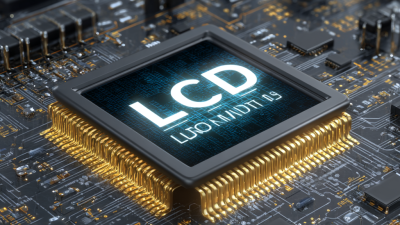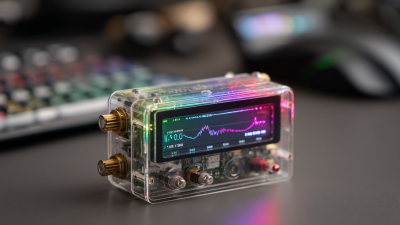Leave Your Message
As technology continues to evolve, the demand for Embedded LCD Displays is on the rise, driving innovation across various industries. According to a recent market report by ResearchAndMarkets, the global embedded display market is projected to reach USD 7.2 billion by 2025, growing at a CAGR of 6.2% from 2020 to 2025.

Embedded LCD Displays play a crucial role in a wide array of applications, ranging from consumer electronics to industrial equipment, due to their compact size and versatility. Furthermore, advancements in display technologies and manufacturing processes are paving the way for higher resolution, improved energy efficiency, and enhanced user interfaces.
This blog aims to provide a comprehensive understanding of Embedded LCD Displays, exploring key trends, technical insights, and the pivotal role they play in shaping the future of modern electronics.
Embedded LCD displays have become integral to modern applications, thanks to their unique features that cater to specific market needs. One of the most significant trends is the shift toward smaller, high-resolution displays that provide enhanced user experiences. According to a recent report by MarketsandMarkets, the global embedded display market is projected to reach $9.3 billion by 2025, growing at a CAGR of 5.6%. This growth is driven by increasing demand for compact devices in sectors such as consumer electronics, automotive, and smart home technologies.
Key features of embedded LCD displays include low power consumption, high durability, and diverse form factors. For instance, many modern displays integrate power-efficient technologies that can reduce energy usage by up to 30%, making them ideal for battery-operated devices. Furthermore, advancements in touch screen technology allow for seamless user interaction, significantly enhancing functionality in applications ranging from industrial automation to medical devices.
Tip: When selecting an embedded LCD display, consider the operating conditions and environmental factors such as temperature and humidity, as these can drastically impact the display's performance and longevity. Additionally, ensure compatibility with the intended hardware to avoid integration issues. Another essential aspect is the resolution; higher resolutions can improve the clarity of visual data, which is crucial for applications that rely on precise information delivery, such as in healthcare monitoring systems.
The landscape of display technology is rapidly evolving, driven by the demand for greater flexibility and integration in embedded systems. One of the most significant trends is the shift towards flexible LCD displays, which offer enhanced versatility for various applications. These displays can be bent and shaped to fit unconventional surfaces, making them ideal for innovative product designs across industries such as automotive, healthcare, and consumer electronics. The ability to integrate these flexible displays seamlessly into devices allows manufacturers to create more compact and lightweight solutions while maintaining high-quality visuals.

Moreover, the convergence of display technologies with smart integration capabilities is shaping the future of embedded systems. As the Internet of Things (IoT) expands, displays are becoming increasingly interactive, enabling real-time data visualization and user engagement. The integration of touch functionality and connectivity features into LCD displays is empowering users to interact intuitively with their devices. This smart integration not only enhances user experience but also opens up new possibilities for applications in smart homes, industrial automation, and beyond. As these trends continue to develop, the embedded display market will undoubtedly witness groundbreaking innovations that redefine how we perceive and interact with technology.
As we approach 2025, the market for embedded LCD displays is projected to experience significant growth, driven by technological advancements and increasing applications across various industries. Projections suggest that in-cell touch TFT LCD displays will dominate automotive central stack display shipments, claiming over 50% market share by the end of the year. This trend highlights the critical role of integrated display solutions in enhancing user experience within vehicles, aligning with broader shifts towards smart, connected automotive technologies.
Moreover, the Display Week 2025 is set to showcase the latest innovations in embedded displays, including the anticipated rise of micro LED applications. With its superior brightness and energy efficiency, micro LED technology is lighting up the future of display solutions in numerous sectors. The event serves as a platform for industry leaders to highlight these advancements and the growing relevance of embedded displays in applications ranging from consumer electronics to automotive and beyond. As these trends coalesce, embedded LCD displays are primed to play a pivotal role in shaping the future of visual technology.
When evaluating embedded LCD displays, understanding their technical specifications is crucial for choosing the right solution for your application. Key metrics such as resolution, contrast ratio, and power consumption directly influence performance and usability. According to a recent report by MarketsandMarkets, the global embedded display market is projected to grow from $7.78 billion in 2020 to $12.96 billion by 2025, highlighting the increasing demand for high-quality visual technologies. The resolution of embedded LCDs, commonly measured in pixels, is critical for applications that require precise visuals. Full HD (1920x1080) and 4K (3840x2160) resolutions are becoming standard options, delivering enhanced clarity and detail.
Contrast ratio is another essential specification, as it defines the difference in luminance between the darkest and the brightest parts of the display. A high contrast ratio, often greater than 1000:1, allows for more dynamic visuals and improved readability in varying lighting conditions. The latest technical insights reveal the trend toward incorporating technologies like OLED and Mini LED, which offer superior contrast ratios and energy efficiency. Furthermore, maintaining low power consumption is vital for embedded applications, as many are deployed in battery-operated devices. Recent advancements in display driver technology have led to reductions in power usage by up to 30%, a critical factor in enhancing device longevity and performance.

Embedded LCD displays have become integral to various sectors, transcending the realm of traditional consumer electronics. In industries like automotive, healthcare, and manufacturing, these displays serve critical functions, enhancing user interfaces and providing real-time data. For instance, in automotive applications, embedded LCDs enable intuitive dashboards that not only present vital vehicle information but also enhance the overall driving experience with smart navigation tools.
In the realm of industrial use, the versatility of embedded LCD displays shines even brighter. They are deployed in control panels, monitoring systems, and machinery interfaces, allowing operators to visualize operations effectively. Moreover, advancements in display technology, such as improved durability and energy efficiency, have made these displays increasingly reliable for harsh environments. As industries continue to seek enhanced efficiency and user engagement, the role of embedded LCD displays is set to expand further, paving the way for innovative applications across diverse fields.
| Application Area | Display Type | Screen Size (inches) | Resolution (pixels) | Brightness (nits) | Power Consumption (W) |
|---|---|---|---|---|---|
| Consumer Electronics | TFT LCD | 5.5 | 1920x1080 | 450 | 2.5 |
| Industrial | OLED | 7.0 | 1280x800 | 1000 | 5.0 |
| Medical Devices | LCD | 10.1 | 1280x720 | 300 | 3.0 |
| Automotive | IPS LCD | 12.3 | 1920x720 | 600 | 4.5 |






